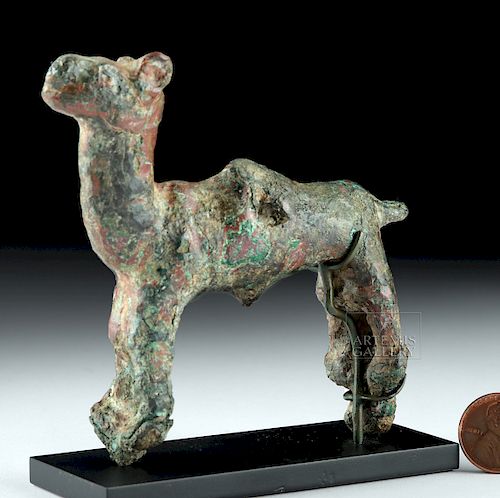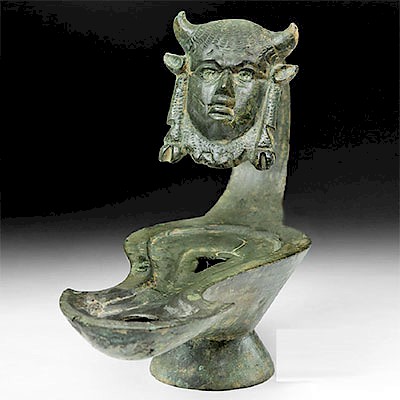Ancient South Arabian Bronze Statuette - Camel
Lot 83
About Seller
Artemis Fine Arts
686 S Taylor Ave, Ste 106
Louisville, CO 80027
United States
Selling antiquities, ancient and ethnographic art online since 1993, Artemis Gallery specializes in Classical Antiquities (Egyptian, Greek, Roman, Near Eastern), Asian, Pre-Columbian, African / Tribal / Oceanographic art. Our extensive inventory includes pottery, stone, metal, wood, glass and textil...Read more
Estimate:
$1,000 - $1,500
Absentee vs Live bid
Two ways to bid:
- Leave a max absentee bid and the platform will bid on your behalf up to your maximum bid during the live auction.
- Bid live during the auction and your bids will be submitted real-time to the auctioneer.
Bid Increments
| Price | Bid Increment |
|---|---|
| $0 | $25 |
| $300 | $50 |
| $1,000 | $100 |
| $2,000 | $250 |
| $5,000 | $500 |
| $10,000 | $1,000 |
| $20,000 | $2,500 |
| $50,000 | $5,000 |
| $100,000 | $10,000 |
| $200,000 | $20,000 |
About Auction
By Artemis Fine Arts
Sep 27, 2018
Set Reminder
2018-09-27 10:00:00
2018-09-27 10:00:00
America/New_York
Bidsquare
Bidsquare : Antiquities | Asian | Ethnographic
https://www.bidsquare.com/auctions/artemis-gallery/antiquities-asian-ethnographic-3469
Featuring classical antiquities, ancient and ethnographic art from cultures encompassing the globe. Artemis Fine Arts info@artemisgallery.com
Featuring classical antiquities, ancient and ethnographic art from cultures encompassing the globe. Artemis Fine Arts info@artemisgallery.com
- Lot Description
Ancient South Arabia, Yemen, ca. early first millennium BCE. A cast bronze statuette of a camel with an erect head and neck, a slight hump, and a friendly face with big, round eyes that gives him a charming look. Deep wells on either side of the center of the body may have once been pierced all the way through and since has been filled in with soil deposits. Perhaps this item could be worn as a pendant when first made. Size: 4" W x 3.55" H (10.2 cm x 9 cm); 3.9" H (9.9 cm) on included custom stand.
This camel is posed as if walking, a dynamic form for an animal whose ability to walk was prized above all else by the South Arabians. The camel was domesticated in South Arabia some time during the Bronze Age (ca. 3000 BCE), and rapidly became central to its economy. Camels allowed them to traverse the vast desert of the Rub' al-Khali, "the Empty Quarter", and were the main method of transport for long-distance trade north to the huge urban centers of the ancient Near East. In turn, South Arabia became famous as a source of perfumes and incense necessary to religious ceremonies in Mesopotamia and beyond. Bronze camel statuettes like this one seem to have been votive offerings, often presented as this one is without inscription. For example, many were found as funerary offerings in various necropoli.
Provenance: private East Coast, USA collection
All items legal to buy/sell under U.S. Statute covering cultural patrimony Code 2600, CHAPTER 14, and are guaranteed to be as described or your money back.
A Certificate of Authenticity will accompany all winning bids.
We ship worldwide and handle all shipping in-house for your convenience.
#137227Mottled brown and green patina on surface. Some small cracks on the surface, notably one ear and foot.Condition
- Shipping Info
-
All shipping is handled in-house for your convenience. Your invoice from Artemis Gallery will include shipping calculation instructions. If in doubt, please inquire BEFORE bidding for estimated shipping costs for individual items.
-
- Buyer's Premium



 EUR
EUR CAD
CAD AUD
AUD GBP
GBP MXN
MXN HKD
HKD CNY
CNY MYR
MYR SEK
SEK SGD
SGD CHF
CHF THB
THB














